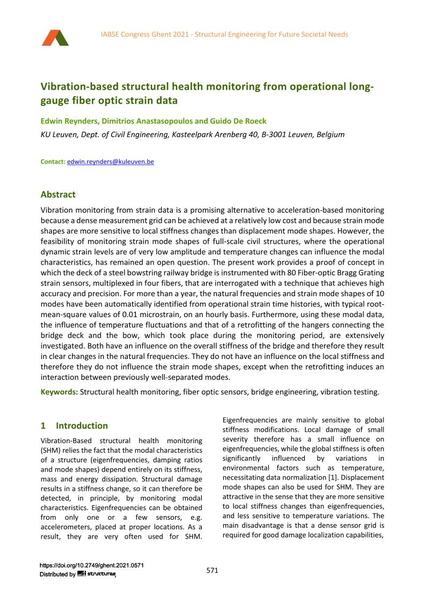Vibration-based structural health monitoring from operational long- gauge fiber optic strain data

|
|
|||||||||||
Bibliographic Details
| Author(s): |
Edwin Reynders
(KU Leuven, Dept. of Civil Engineering, Kasteelpark Arenberg 40, B-3001 Leuven, Belgium)
Dimitrios Anastasopoulos (KU Leuven, Dept. of Civil Engineering, Kasteelpark Arenberg 40, B-3001 Leuven, Belgium) Guido De Roeck (KU Leuven, Dept. of Civil Engineering, Kasteelpark Arenberg 40, B-3001 Leuven, Belgium) |
||||
|---|---|---|---|---|---|
| Medium: | conference paper | ||||
| Language(s): | English | ||||
| Conference: | IABSE Congress: Structural Engineering for Future Societal Needs, Ghent, Belgium, 22-24 September 2021 | ||||
| Published in: | IABSE Congress Ghent 2021 | ||||
|
|||||
| Page(s): | 571-579 | ||||
| Total no. of pages: | 9 | ||||
| DOI: | 10.2749/ghent.2021.0571 | ||||
| Abstract: |
Vibration monitoring from strain data is a promising alternative to acceleration-based monitoring because a dense measurement grid can be achieved at a relatively low cost and because strain mode shapes are more sensitive to local stiffness changes than displacement mode shapes. However, the feasibility of monitoring strain mode shapes of full-scale civil structures, where the operational dynamic strain levels are of very low amplitude and temperature changes can influence the modal characteristics, has remained an open question. The present work provides a proof of concept in which the deck of a steel bowstring railway bridge is instrumented with 80 Fiber-optic Bragg Grating strain sensors, multiplexed in four fibers, that are interrogated with a technique that achieves high accuracy and precision. For more than a year, the natural frequencies and strain mode shapes of 10 modes have been automatically identified from operational strain time histories, with typical root- mean-square values of 0.01 microstrain, on an hourly basis. Furthermore, using these modal data, the influence of temperature fluctuations and that of a retrofitting of the hangers connecting the bridge deck and the bow, which took place during the monitoring period, are extensively investigated. Both have an influence on the overall stiffness of the bridge and therefore they result in clear changes in the natural frequencies. They do not have an influence on the local stiffness and therefore they do not influence the strain mode shapes, except when the retrofitting induces an interaction between previously well-separated modes. |
||||
| Keywords: |
structural health monitoring bridge engineering Fiber optic sensors vibration testing
|
||||
| Copyright: | © 2021 International Association for Bridge and Structural Engineering (IABSE) | ||||
| License: | This creative work is copyrighted material and may not be used without explicit approval by the author and/or copyright owner. |
||||
